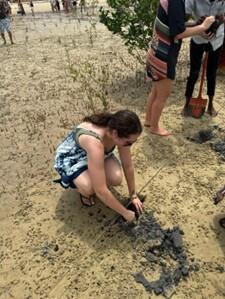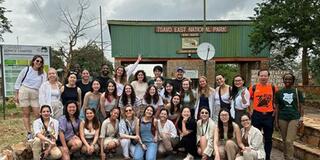
Kenya Trek 2024: Shannon McKeown’s Story

During school breaks, a few student organizations at SIPA host a trek–a trip for SIPA students to explore a country represented or relevant to the host organization. For instance, the SIPA Greater China Initiative hosted a trek to China, Columbia SIPA’s Latin American and Caribbean Student Association arranged one to Colombia, and the SIPA Pan-African Network (SPAN) of Columbia University conducted a trek to Kenya. In January 2024, Shannon McKeown (MIA-EPD’24) participated in the Kenya Trek and we will hear about her experience exploring Kenya in 11 days!
What is a trek at SIPA? Can you share the overall experience of Kenya Trek?
A trek is a unique learning opportunity to understand better and engage with the people, culture, politics, and environment of a particular country beyond the constraints of the classroom. As future policymakers, it is important to understand the local contexts in which we hope to work one day. These treks serve as cultural and educational exchanges to broaden our understanding and challenge our preconceived (and largely Western) ideas.
On this year’s Kenya Trek, the focus was to learn about conservation efforts, community development, and the relationships between people, wildlife, and the environment in Kenya. The SIPA Pan-African Network and RIDE International were great facilitators of the trek and made sure to curate both an engaging and educational itinerary. Each day we had a different focus depending on our activities and location. With nearly every activity, we listened to local experts in marine conservation, wildlife, aquaculture, and agriculture which provided us with invaluable perspectives. This free-flowing exchange of ideas and opinions across different cultures and languages made the trek an unforgettable experience.
What motivated you to participate in the Kenya Trek?
I was motivated by several reasons to participate in the trek, mostly due to my curiosity to better understand local economic development in Kenya and learn from local experts. I wanted to travel to Kenya for nearly a decade, largely because of two excellent classes I took during my undergraduate degree where we discussed Kenya’s history, politics, and political institutions. I continued my interest at SIPA where I took Environment, Development, and Politics with Professor Harry Verhoeven. In his class, I wrote an essay on the failure of neoliberal economic policies in Kenya in the 1980s and 1990s which led me to question the efficacy of free market reforms, the “Washington Consensus,” and other Western-led economic policies. I grew curious about approaches to community-driven economic development in Kenya. I also was lucky enough to take another great class at SIPA, Financial Inclusion with Professors Louise Moretto and Camilla Nestor, where we discussed the success of M-PESA, Kenya’s mobile phone-based money transfer service. My previous coursework gave me a solid understanding of Kenya’s history and macroeconomic policies, but I still had questions about the intersection of technology, economic development, and the environment. Unfortunately, there are not enough classes that focus on sub-Saharan Africa at SIPA (let alone East Africa or Kenya), so this trek allowed me to explore my interest in learning more about Kenya outside of the classroom.

What activities did you do in Kenya? Were there any experiences interacting with the community there?
We participated in a wide range of activities in Kenya from Nairobi to Kasigau to Diani, all of which involved interacting and hearing from local community members. We began in Nairobi where we had a great trip to the Giraffe Center and heard from Dr. Mordecai Ogada, an expert on animal ecology and conservation policy, on conservation issues in Kenya. We also met with representatives from the U.S. embassy and USAID and heard about U.S. strategic priorities in Kenya and East Africa. We then traveled to Kasigau, where we spent the day with small-holder farmers who graciously invited us for lunch, walked us through their farms, and showed us how to harvest corn and shell black-eyed peas. Together we ate ugali, Kenya’s staple dish, and chatted about a wide range of topics. That same day, we met with a group of approximately 20 women basket weavers who taught us how to weave and shared with us the importance of their baskets for their economic empowerment and fostering a sense of community amongst the women. We also went on patrol with the Elephant Guardians, a group of volunteers who each evening prevent elephants from wandering onto farms and eating crops.
One morning, we hiked up Kasigau mountain where we learned about the flora, fauna, bugs, and other species that contribute to the ecosystem's success and enjoyed beautiful views of Taita-Taveta county. We headed to Kenya’s biggest national park, Tsavo East National Park, for a safari where we were lucky to see zebras, antelopes, hippos, crocodiles, lions, giraffes, and impalas. My favorite part of the safari was not just the big animals, but the birds that flew alongside our truck and disappeared in a flash of color. After Kasigau, we traveled east to Diani Beach on the Swahili Coast where we went on a morning patrol with Sea Turtle Police and toured Funzi Island, where we met with several Funzi residents and learned and participated in the community’s mangrove restoration efforts. Throughout the trek, the people we met were consistently generous with their time and knowledge and made our experience incredibly enriching.
What were some highlights of the trip?
My favorite day of the trek was the time we spent on Funzi Island, a small island near Diani Beach. We spent nearly the entire day there, meeting with people, and learning about the local economy and environment, the importance of mangroves, and their partnerships with NGOs. We had a long discussion about community needs, gender roles, and environmental management. Our hosts were kind enough to set aside mangroves for our group to plant together alongside community volunteers. It was a great experience; we not only got our hands dirty (literally and figuratively) but left with a greater understanding and appreciation for the symbiotic nature of humans, environment, and wildlife.
Can you share any tips for students who want to participate in the future?
Treks like these are an opportunity to immerse yourself in a different environment, exhibit compassion and gratitude to the people you meet, and leave your biases at home. Whenever you are traveling to a new country, you should have an open mind and embrace discomfort. At the end of the day, you are a visitor in someone else’s home, and you should act appropriately. You should not impose your expectations or standards; flexibility and adaptability are important. The most important thing you can do is to actively listen and engage with people from a place of genuine curiosity and kindness. And of course, wholeheartedly enjoy the experience and take lots of photos!